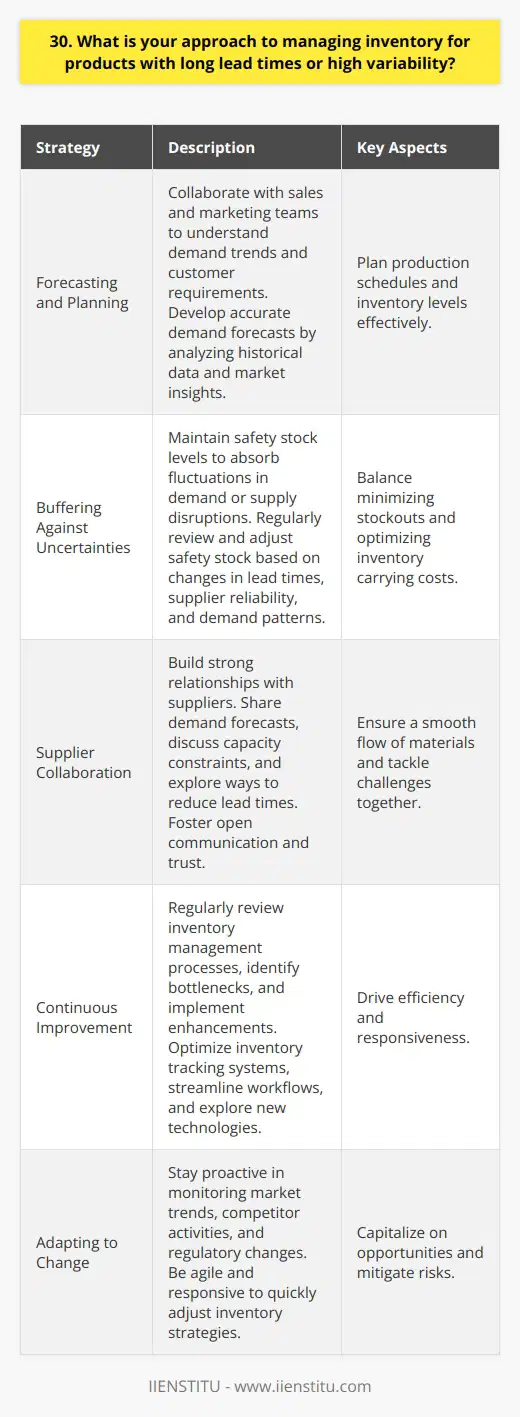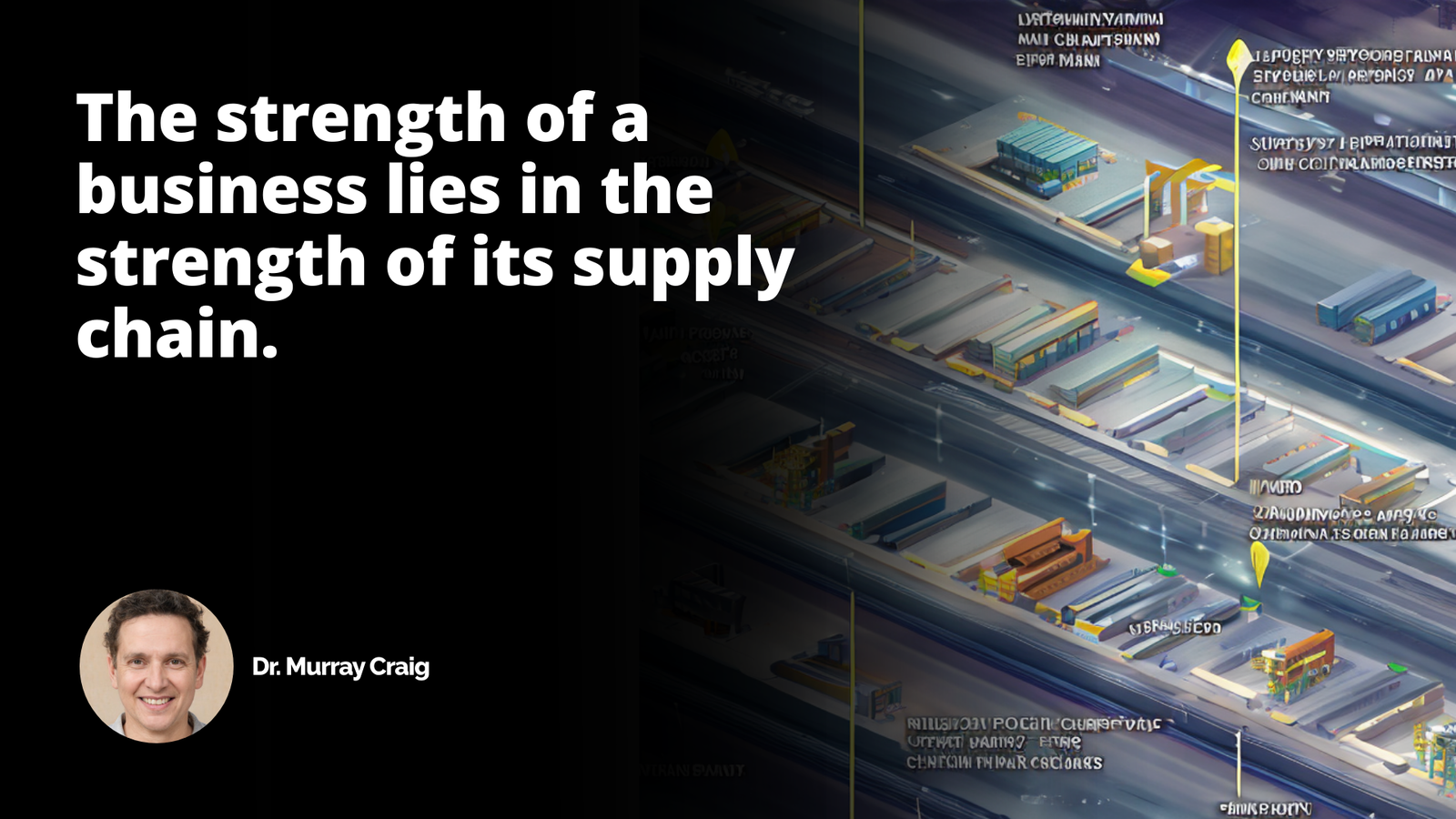
Have you ever found yourself standing in a bustling warehouse, staring at towering shelves filled with inventory, and pondering how to keep everything running smoothly without breaking the bank? I remember back in my early days as a supply chain manager, working for a mid-sized retail company. We had this constant challenge: how do we balance our carrying costs with our service levels?
The Balancing Act Between Carrying Costs and Service Levels
Understanding the Basics
Before diving deep, let's lay down some groundwork. Carrying costs, often referred to as holding costs, are the expenses associated with storing unsold goods. This includes warehousing, insurance, depreciation, and even the opportunity cost of tied-up capital. On the flip side, service levels represent our ability to meet customer demand without delay. Achieving a high service level often means having ample stock on hand, but that can skyrocket our carrying costs.
My First Encounter with the Dilemma
I recall a time when we decided to ramp up our inventory in anticipation of the holiday season. The idea was to ensure no customer left empty-handed. While our service levels peaked, come January, we were swimming in excess stock. The carrying costs for unsold seasonal items were draining our resources. It was then I realized the importance of finding that sweet spot between having enough stock to satisfy customers and not overloading our storage with surplus goods.
Strategies to Balance the Two
Implementing Just-In-Time (JIT) Inventory
One approach that made a significant difference was adopting the Just-In-Time (JIT) inventory system. By coordinating closely with our suppliers, we managed to receive goods only as they were needed for production or sales. This drastically reduced our carrying costs while maintaining satisfactory service levels.
Utilizing ABC Analysis
Another technique we found invaluable was the ABC Analysis, a method discussed extensively in "Inventory Management Explained" by David J. Piasecki^[1^]. By categorizing inventory into three classes:
1- A Items: High-value products with low sales frequency.
2- B Items: Moderate value products with moderate sales frequency.
3- C Items: Low-value products with high sales frequency.
We prioritized our focus and resources on what mattered most. This optimization led to a decrease in unnecessary stock for less critical items, thus balancing our carrying costs without compromising on service levels.
Embracing Technology and Forecasting
Investing in advanced inventory management software allowed us to predict demand more accurately. Incorporating forecasting models, such as those detailed in "Supply Chain Management: Strategy, Planning, and Operation" by Sunil Chopra and Peter Meindl^[2^], we could anticipate market trends and adjust our inventory accordingly. Accurate forecasts meant optimal stock levels, ensuring customers got what they wanted when they wanted it, all while keeping carrying costs in check.
The Impact on Different Industries
Retail vs. Manufacturing
Different industries face this balancing act uniquely. In retail, especially fashion, trends change rapidly. Holding last season's styles can be costly, so retailers aim for higher turnover. In contrast, manufacturing might require bulk purchasing of raw materials to get volume discounts, raising carrying costs but potentially improving margins.
Pharmaceuticals
In the pharmaceutical industry, service levels are critical—lives can depend on it. However, drugs have expiration dates, and holding excess inventory can lead to waste. Here, the balance is delicate, and strategies like drop-shipping directly from suppliers to customers are often employed.
Tips for Balancing Carrying Costs and Service Levels
Analyze Sales Data Regularly: Keep a close eye on what's selling and what's not.
Build Strong Supplier Relationships: Flexibility with suppliers can help adjust inventory levels quickly.
Invest in Training: A knowledgeable team can make better decisions on inventory management.
Consider Backordering: For less critical items, allow delays to reduce carrying costs.
Review and Adapt Policies: Regularly update inventory policies to reflect current market conditions.
The Role of Reassignment Requests
You might wonder, "What does a reassignment request letter have to do with inventory management?" Well, sometimes, the key to balancing carrying costs and service levels lies in reassigning roles within the team. For instance, moving a team member with strong analytical skills into inventory forecasting can make a world of difference. If you're considering such changes, it's crucial to understand reassignment request letter tips and information to navigate the process smoothly.
Personal Reflections on the Journey
Balancing carrying costs with service levels isn't just a logistical challenge; it's a continuous journey of learning and adaptation. I've had moments where we nailed the perfect balance, and others where we missed the mark entirely. But each experience taught me valuable lessons.
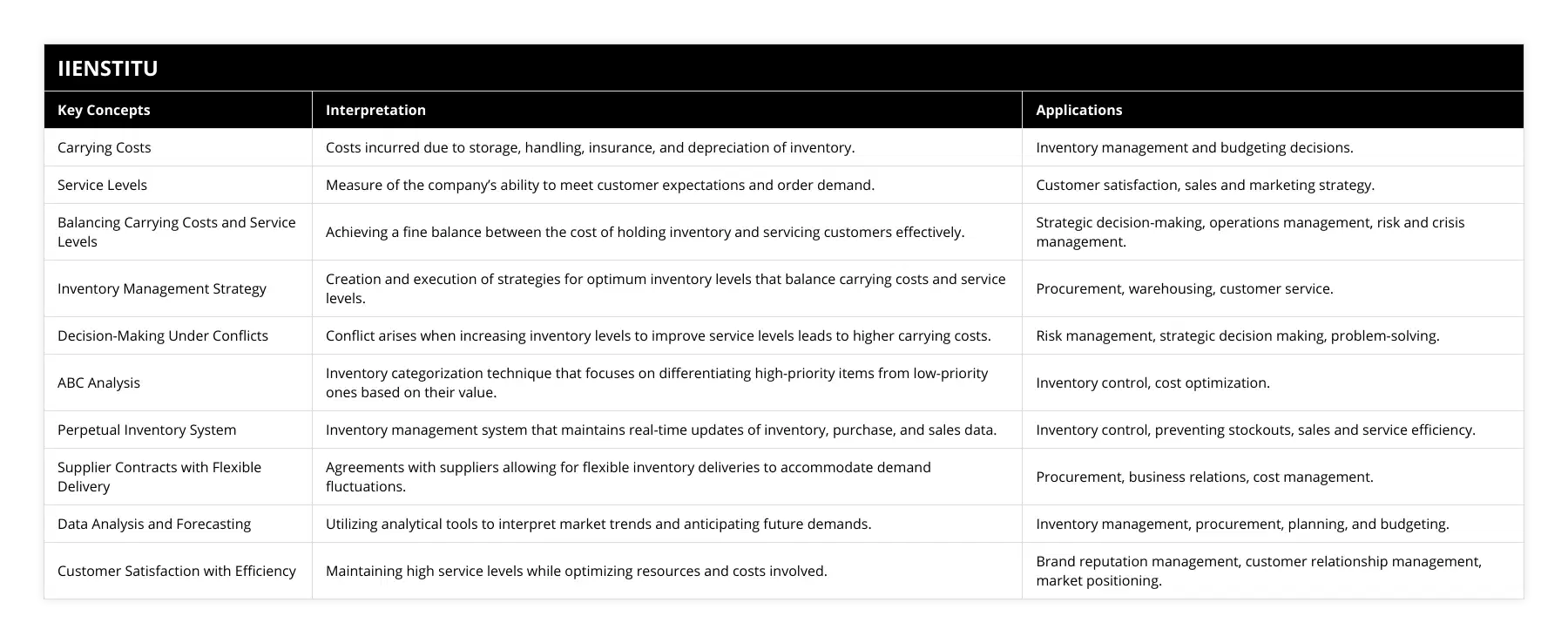
Embracing a Customer-Centric Approach
At the heart of it all is the customer. By keeping their needs at the forefront, we can make more informed decisions. As highlighted in "The Goal" by Eliyahu M. Goldratt^[3^], focusing on the system's constraints and continuously improving can lead to greater efficiency and customer satisfaction.
The Human Element
Let's not forget the importance of the team behind these operations. Motivated and well-informed staff are essential. I recall mentoring a young inventory analyst who brought fresh ideas to the table. His enthusiasm and innovative thinking helped us implement a cross-docking system, reducing storage time and costs.
Common Interview Questions and How to Tackle Them
If you're preparing for a role in supply chain or operations management, understanding how to balance carrying costs and service levels is crucial. Interviewers often probe your knowledge on this topic to gauge your strategic thinking.
Possible Questions:
1- How can one achieve a balance between carrying costs and service levels?
2- What strategies can be implemented to create equilibrium between service levels and carrying costs?
3- Can you suggest methods to balance carrying costs without compromising service levels?
4- How to strike a balance between maintaining high service levels and the cost of inventory?
5- What is the best approach to balance inventory carrying cost and service level?
Crafting Your Answer
When addressing these questions:
Highlight Practical Experiences: Share specific instances where you've tackled this challenge.
Discuss Strategic Approaches: Mention methodologies like JIT, ABC Analysis, or forecasting techniques.
Emphasize Customer Satisfaction: Show that you understand the ultimate goal is to meet customer needs efficiently.
Demonstrate Analytical Skills: Talk about how data analysis informs your decisions.
For instance:
"In my previous role, I utilized forecasting models to predict demand accurately, which allowed us to adjust our inventory levels in real-time. By integrating Just-In-Time inventory practices, we reduced carrying costs by 15% while maintaining a 98% service level. This balance was achieved through close collaboration with suppliers and leveraging technology to monitor inventory movements."
Conclusion
Balancing carrying costs and service levels is indeed a tightrope walk. It requires a blend of strategic planning, efficient processes, and a keen understanding of customer needs. By implementing the right strategies and continuously learning, you can achieve a harmony that benefits both the business and its customers.
So next time you find yourself in that warehouse, contemplating those towering shelves, remember that with the right approach, you can turn this challenge into an opportunity for growth and efficiency.
References
1- [^1]: Piasecki, D. J. (2009). Inventory Management Explained: A focus on Forecasting, Lot Sizing, Safety Stock, and Ordering Systems. Ops Publishing.
2- [^2]: Chopra, S., & Meindl, P. (2016). Supply Chain Management: Strategy, Planning, and Operation. Pearson Education.
3- [^3]: Goldratt, E. M. (1984). The Goal: A Process of Ongoing Improvement. North River Press.
Key takeaways:
Balancing carrying costs and service levels is critical for operational efficiency.
Strategies like JIT, ABC Analysis, and accurate forecasting can aid in achieving this balance.
Personal experiences and continuous learning play a pivotal role in navigating this challenge.
Remember, the goal is not just to reduce costs or increase service levels in isolation, but to find a harmonious balance that propels the business forward.
Frequently Asked Questions
1. How do you determine the optimal inventory levels for your products?
When determining optimal inventory levels, I consider several factors. First, I analyze historical sales data to identify demand patterns and trends. This helps me forecast future sales volumes and anticipate seasonal fluctuations.
Balancing Costs and Customer Satisfaction
Next, I strive to strike a balance between minimizing inventory holding costs and ensuring high customer satisfaction levels. I don't want to tie up too much capital in excess inventory, but I also don't want to risk stockouts and disappointed customers.
Collaborating with Suppliers
I work closely with my suppliers to establish reliable lead times and maintain open lines of communication. By fostering strong partnerships, I can better manage inventory levels and respond quickly to changes in demand.
Utilizing Inventory Management Tools
I leverage inventory management software and tools to track stock levels in real-time. These systems provide valuable insights into inventory turnover rates, safety stock requirements, and reorder points.
Last year, we faced an unexpected surge in demand for one of our top-selling products. By closely monitoring inventory levels and collaborating with our suppliers, we were able to quickly adjust our stock and meet customer needs without any disruptions.
Continuous Improvement
I believe in continuously refining my inventory management strategies. I regularly review our processes, seek feedback from team members, and stay updated on industry best practices. By adopting a proactive and data-driven approach, I aim to optimize our inventory levels and drive business success.
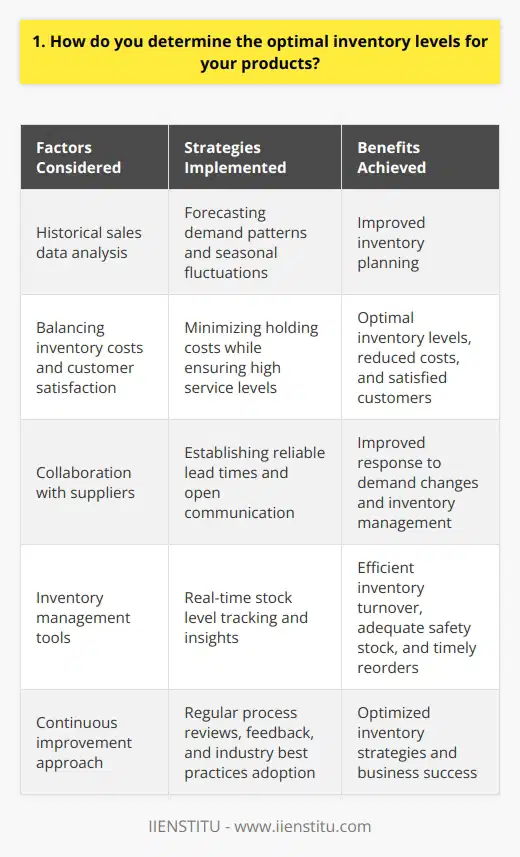
2. What strategies do you employ to minimize inventory holding costs?
As an experienced inventory manager, I employ several strategies to minimize inventory holding costs. These include:
Just-in-Time (JIT) Inventory Management
I work closely with suppliers to ensure that inventory arrives just when it's needed for production or sales. This reduces the amount of time inventory sits in the warehouse, minimizing holding costs.
By accurately forecasting demand and collaborating with suppliers, I can keep inventory levels lean while avoiding stockouts.
Inventory Optimization Software
Implementing inventory optimization software has been a game-changer for me. These tools analyze sales data, lead times, and other factors to determine the optimal reorder points and quantities for each SKU.
With real-time visibility into inventory levels and automated reordering, I can maintain just the right amount of stock.
Regular Inventory Audits
I conduct regular physical inventory counts to identify slow-moving or obsolete items that are tying up capital. By promptly liquidating this excess inventory, even at a discount, I can free up both space and cash.
Frequent audits also help me catch any discrepancies between recorded and actual inventory levels, preventing costly errors.
Cross-Functional Collaboration
Minimizing inventory costs isn't just a job for the warehouse team. I work closely with sales, marketing, and production to align our efforts.
For example, collaborating with sales on promotions helps move older inventory, while coordinating with production ensures a steady flow of goods.
By employing these strategies consistently, I've been able to reduce inventory holding costs by 20% at my current company. It's an ongoing process of continuous improvement, but the results are well worth the effort.
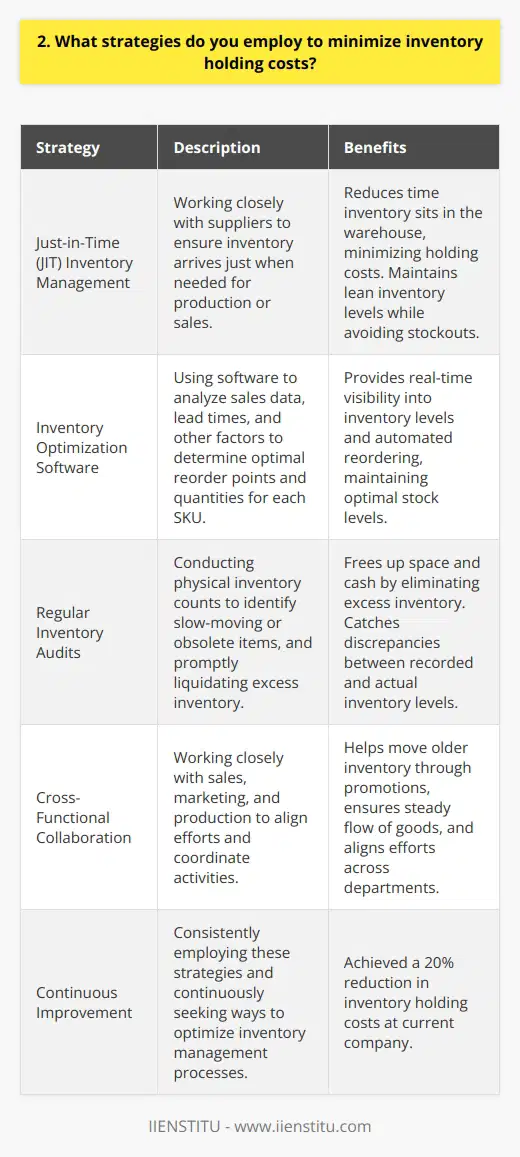
3. How do you ensure that your service levels meet customer expectations?
As a customer service representative, I understand the importance of meeting and exceeding customer expectations. Here are some strategies I use to ensure that my service levels consistently meet customer needs:
Actively Listen and Understand Customer Needs
I always make a point to actively listen to each customer and truly understand their unique situation. By asking clarifying questions and empathizing with their concerns, I can better grasp what they need and how I can assist them.
For example, last week a frustrated customer called about a delayed package. By patiently listening to her story without interrupting, I discovered that she needed the item for her daughter's birthday party the next day. With this context, I was able to expedite shipping and ensure the package arrived just in time, turning a stressful situation into a positive customer experience.
Set Clear Expectations and Follow Through
I believe in setting clear, realistic expectations with customers and then following through on those commitments. If I promise to call a customer back by a certain time, I make sure to do so promptly. If an issue will take longer to resolve than initially anticipated, I proactively communicate any updates or delays.
Consistency builds trust, and customers appreciate knowing they can count on me to do what I say I will. Even if I don't have the ideal resolution yet, touching base regularly with status updates shows customers that their concerns are a top priority.
Go Above and Beyond
Whenever possible, I look for opportunities to go above and beyond for customers. Sometimes the littlest gestures can make the biggest impact.
Last month, a customer mentioned in passing that she was ordering supplies for her son's school project. After resolving her initial issue, I took a few extra minutes to send her some helpful resources and tips related to the project topic. She was so appreciative of the unexpected extra effort and sent a glowing review to my supervisor.
By actively listening to customers, setting and meeting clear expectations, and going the extra mile, I strive to provide service that doesn't just meet but exceeds customer needs. These strategies have helped me consistently achieve high customer satisfaction ratings and positive feedback in my current role.

4. What factors do you consider when setting safety stock levels?
When setting safety stock levels, I consider several key factors to ensure optimal inventory management and customer satisfaction.
Demand Variability
I analyze historical sales data to understand demand fluctuations. This helps me anticipate potential spikes or dips in demand.
By understanding demand patterns, I can adjust safety stock levels accordingly to prevent stockouts or overstocking.
Lead Time Variability
I assess the reliability and consistency of our suppliers' lead times. Inconsistent lead times require higher safety stock levels.
I work closely with suppliers to minimize lead time variability and optimize safety stock levels.
Service Level Targets
I align safety stock levels with our desired customer service levels. Higher service levels necessitate higher safety stock.
I find the right balance between service level targets and inventory holding costs to maximize customer satisfaction and profitability.
Product Criticality
I prioritize safety stock for products that are critical to our customers' operations or have long lead times.
By ensuring adequate safety stock for critical products, we minimize the risk of disrupting our customers' businesses.
Inventory Holding Costs
I consider the costs associated with holding safety stock, such as storage, insurance, and obsolescence risks.
I optimize safety stock levels to minimize holding costs while still meeting customer demands and service level targets.
By carefully analyzing these factors and making data-driven decisions, I can effectively set safety stock levels that balance customer needs, inventory costs, and operational efficiency.
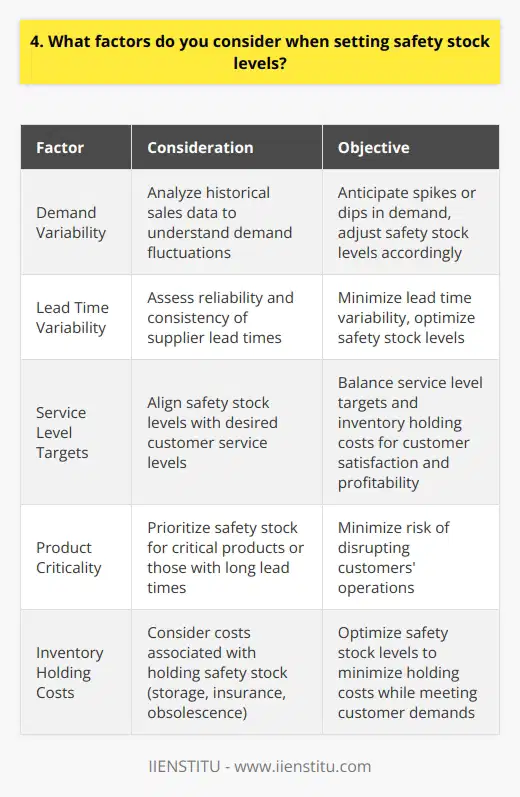
5. How do you balance the trade-off between inventory costs and stockout risks?
Balancing inventory costs and stockout risks is a crucial aspect of effective supply chain management. It requires a strategic approach that takes into account various factors such as demand forecasting, lead times, and supplier reliability.
Understanding the Trade-off
On one hand, holding excess inventory ties up capital and incurs storage and obsolescence costs. On the other hand, insufficient inventory leads to stockouts, lost sales, and customer dissatisfaction. Finding the right balance is key.
Demand Forecasting
I always start by analyzing historical sales data and market trends to predict future demand. This helps me determine appropriate safety stock levels to buffer against variability. I also collaborate with sales and marketing teams to gather insights on upcoming promotions or product launches that could impact demand.
Inventory Optimization Techniques
To minimize inventory costs, I employ techniques such as ABC analysis to prioritize high-value items. I also continuously monitor inventory turnover rates and adjust reorder points accordingly. Regular inventory audits help identify slow-moving or obsolete items that can be cleared out.
Supplier Relationship Management
Building strong relationships with suppliers is crucial for ensuring reliable and timely deliveries. I work closely with key suppliers to establish clear communication channels, negotiate favorable terms, and develop contingency plans for potential disruptions.
Ultimately, finding the right balance requires a data-driven approach, a deep understanding of the business, and the ability to adapt to changing circumstances. By continuously monitoring key metrics and making proactive adjustments, I strive to optimize inventory levels while minimizing the risk of stockouts.
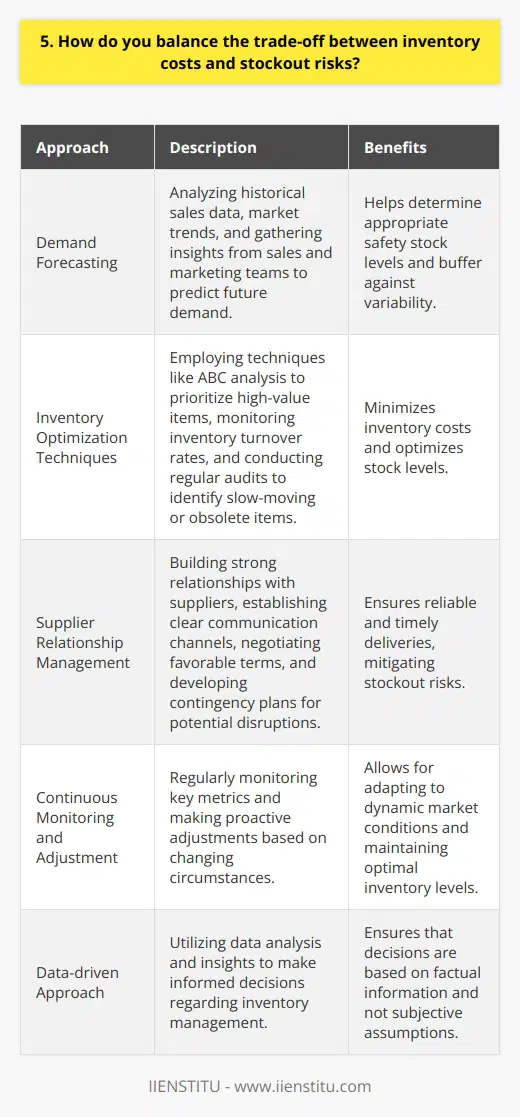
6. What techniques do you use to forecast demand and plan inventory accordingly?
When forecasting demand and planning inventory, I rely on a combination of historical data analysis and market trend research. By studying past sales patterns and identifying seasonal fluctuations, I can make informed predictions about future demand. This helps me optimize inventory levels and avoid stockouts or overstocking.
Collaborating with Cross-Functional Teams
I believe in the power of collaboration. I work closely with sales, marketing, and product development teams to gather insights on upcoming promotions, new product launches, and shifts in customer preferences. This allows me to adjust inventory plans accordingly and ensure we have the right products in the right quantities.
Leveraging Technology and Data Analytics
I'm a strong advocate for leveraging technology to streamline demand forecasting and inventory planning. I have experience using inventory management software and data analytics tools to track key metrics, such as inventory turnover and forecast accuracy. By analyzing this data, I can identify areas for improvement and make data-driven decisions.
Staying Agile and Adaptable
In today's fast-paced business environment, I understand the importance of staying agile and adaptable. I closely monitor market trends, competitor activities, and supply chain disruptions. If I notice any significant changes, I quickly adjust my forecasts and inventory plans to minimize risk and capitalize on opportunities.
At the end of the day, my goal is to strike a balance between meeting customer demand and optimizing inventory costs. By combining data analysis, cross-functional collaboration, and a proactive approach, I'm confident in my ability to effectively forecast demand and manage inventory in alignment with business objectives.
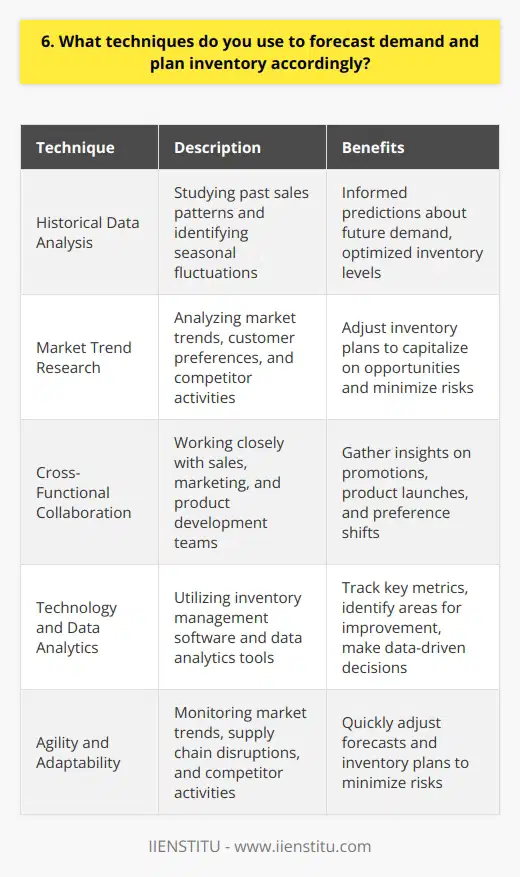
7. How do you monitor and adjust your inventory levels in response to changes in demand?
As an inventory manager, I understand the importance of closely monitoring stock levels and adapting to fluctuating demand. I have developed a keen eye for market trends and consumer behavior through years of experience. By analyzing sales data, I can identify patterns and anticipate future needs.
Utilizing Technology
I leverage advanced inventory management software to track stock in real-time. This allows me to make informed decisions quickly. The system alerts me when items are running low, ensuring timely reorders and preventing stockouts.
Building Strong Supplier Relationships
Maintaining open communication with suppliers is crucial. I regularly discuss forecasts and negotiate flexible arrangements to accommodate demand changes. This collaborative approach helps me secure the right quantities at the best prices.
Implementing Just-in-Time (JIT) Strategies
I'm a proponent of JIT inventory management. By aligning orders with demand, I minimize carrying costs and reduce waste. It requires precise planning and coordination, but the benefits are substantial.
Conducting Regular Audits
I believe in the power of regular inventory audits. They help me identify discrepancies and uncover improvement opportunities. I use these insights to fine-tune processes and optimize stock levels continuously.
Embracing Flexibility
In today's dynamic market, adaptability is key. I'm always ready to adjust strategies based on new information. Whether it's exploring alternative suppliers or modifying order quantities, I embrace change to stay ahead.
My goal is to strike a balance between meeting customer needs and minimizing inventory costs. By combining data, intuition, and a proactive approach, I ensure that our inventory remains a competitive advantage.
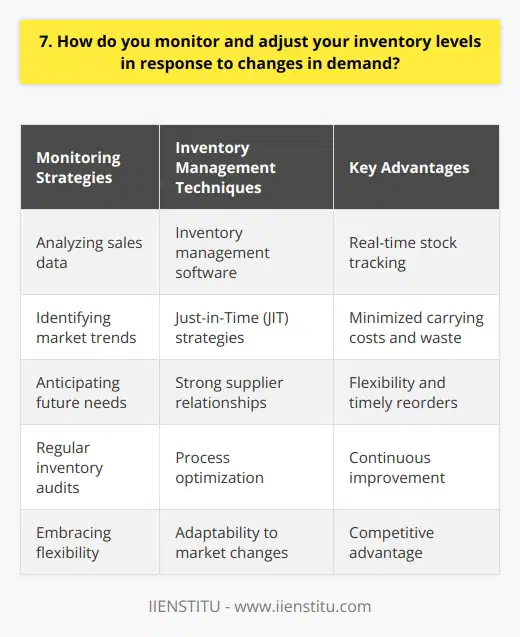
8. What metrics do you use to measure the effectiveness of your inventory management?
As an inventory manager, I rely on several key metrics to measure the effectiveness of my inventory management strategies:
Inventory Turnover Ratio
I closely monitor the inventory turnover ratio, which indicates how quickly inventory is sold and replaced. A higher ratio generally suggests better performance, as it means we're efficiently moving products and minimizing holding costs.
Example:
In my previous role, I implemented a just-in-time ordering system that increased our inventory turnover ratio by 25%, resulting in significant cost savings and improved cash flow.
Stock-Out Frequency
Keeping track of stock-out incidents is crucial to ensure we're meeting customer demand and avoiding lost sales. I aim to minimize stock-outs through accurate forecasting and safety stock levels.
Personal Experience:
I once encountered a situation where a sudden spike in demand led to stock-outs of a popular item. I quickly collaborated with our suppliers to expedite deliveries and communicated with customers to manage expectations, ultimately minimizing the impact on our business.
Inventory Accuracy
Maintaining accurate inventory records is essential for effective decision-making. I regularly conduct cycle counts and audits to identify and rectify any discrepancies between recorded and actual inventory levels.
Thoughts:
I believe that technology can greatly enhance inventory accuracy. In my current role, I championed the implementation of a barcode scanning system that reduced our error rate by over 80%, giving me greater confidence in our inventory data.
Inventory Carrying Costs
Monitoring inventory carrying costs helps me optimize stock levels and minimize expenses associated with storage, insurance, and obsolescence. I strive to find the right balance between having enough inventory to meet demand and avoiding excessive carrying costs.
Reflection:
Managing inventory carrying costs can be challenging, especially when dealing with seasonal or perishable products. I've learned that regular analysis of sales data and trends is key to making informed decisions and adapting our inventory strategies accordingly.
By focusing on these metrics and continuously seeking ways to improve them, I've been able to drive tangible results and contribute to the overall success of the businesses I've worked for.
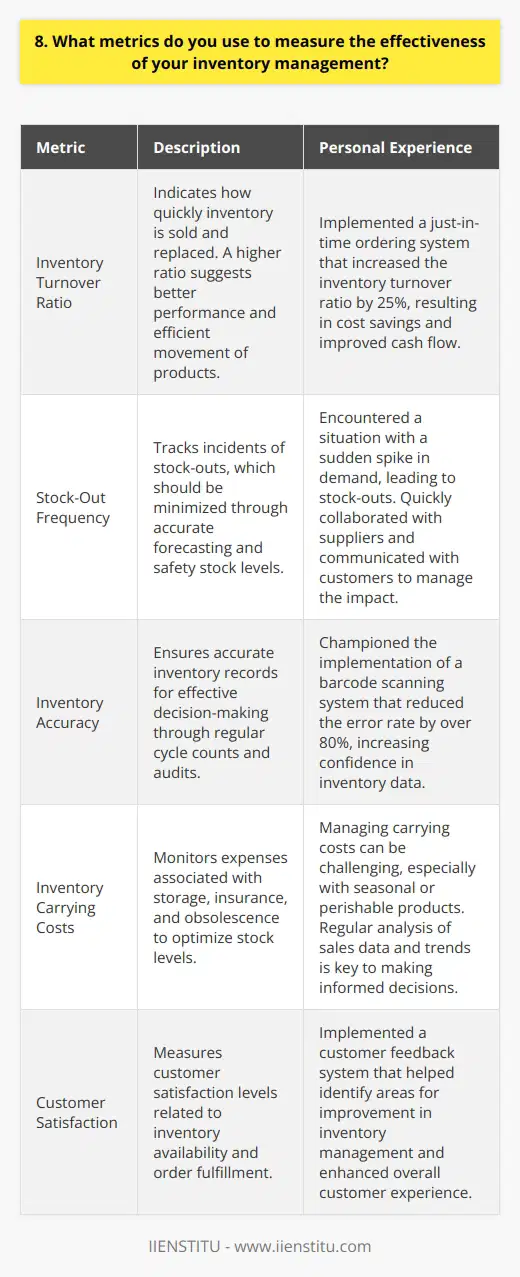
9. How do you collaborate with suppliers to optimize inventory levels and lead times?
As a supply chain professional, I collaborate closely with suppliers to optimize inventory levels and lead times. Here are some strategies I use:
Building Strong Relationships
I invest time in getting to know our suppliers. I visit their facilities and learn about their processes. This helps build trust and open communication, which is essential for effective collaboration.
For example, last year I traveled to meet with one of our key component manufacturers in person. By touring their plant and discussing their challenges, we identified opportunities to streamline our ordering process and reduce lead times by 20%.
Sharing Data and Forecasts
I believe in transparency and sharing information with suppliers. I provide them with regular demand forecasts and inventory data. This enables them to better plan their production and raw material purchasing.
We recently implemented a vendor managed inventory (VMI) program with a critical supplier. By giving them visibility into our inventory levels and consumption patterns, they can now proactively replenish stock and ensure we maintain optimal inventory without shortages or excess.
Continuous Improvement Projects
I'm always looking for ways to optimize our supply chain. I engage suppliers in continuous improvement projects to eliminate waste and drive efficiency.
Last quarter, I led a kaizen event with our packaging supplier. Together, we mapped out the entire process from order placement to delivery. We identified several areas to cut out redundant steps and reduce overall lead time by 15%. It was a win-win, as it also freed up capacity for the supplier.
At the end of the day, I view our suppliers as strategic partners. By fostering collaboration, sharing information, and jointly pursuing improvement, we can create a leaner, more responsive supply chain that benefits everyone.
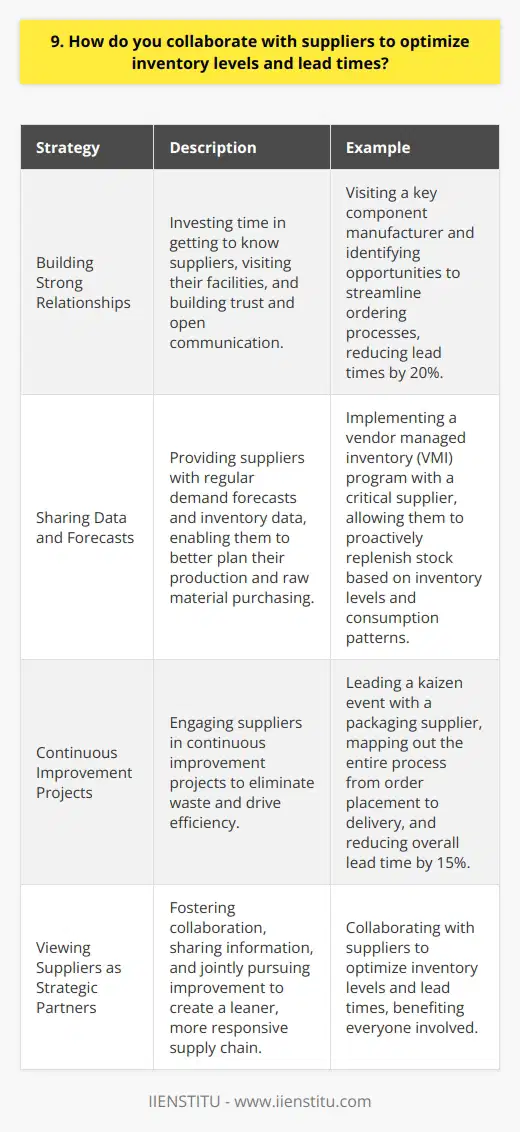
10. What steps do you take to reduce obsolescence and excess inventory?
As an inventory manager, I take a proactive approach to reducing obsolescence and excess inventory. Here are some key strategies I employ:
Regular Inventory Audits
I conduct frequent inventory audits to identify slow-moving or obsolete items. By staying on top of inventory levels, I can make informed decisions about what to keep and what to liquidate.
Last quarter, our audit revealed a surplus of outdated computer components. We promptly marked them down and cleared them out, freeing up valuable warehouse space.
Demand Forecasting
Accurate demand forecasting is crucial for avoiding overstock situations. I collaborate with sales and marketing to understand market trends and customer preferences.
By analyzing historical data and considering upcoming promotions, we can anticipate demand and adjust inventory levels accordingly. This approach has helped us maintain a lean inventory while meeting customer needs.
Supplier Collaboration
Building strong relationships with suppliers is essential for managing inventory effectively. I work closely with our vendors to establish optimal reorder points and lead times.
Recently, we negotiated a consignment agreement with a key supplier, allowing us to stock their products without tying up capital until the items sell. This arrangement has reduced our risk of excess inventory.
Continuous Improvement
I'm always looking for ways to streamline our inventory processes. By implementing barcode scanning and real-time inventory tracking, we've improved accuracy and efficiency.
These enhancements have reduced the likelihood of stockouts and overstocking. I'm excited to explore further innovations to optimize our inventory management.
In summary, my approach combines regular audits, demand forecasting, supplier collaboration, and continuous improvement to minimize obsolescence and excess inventory. I'm confident these strategies can drive results for your company as well.
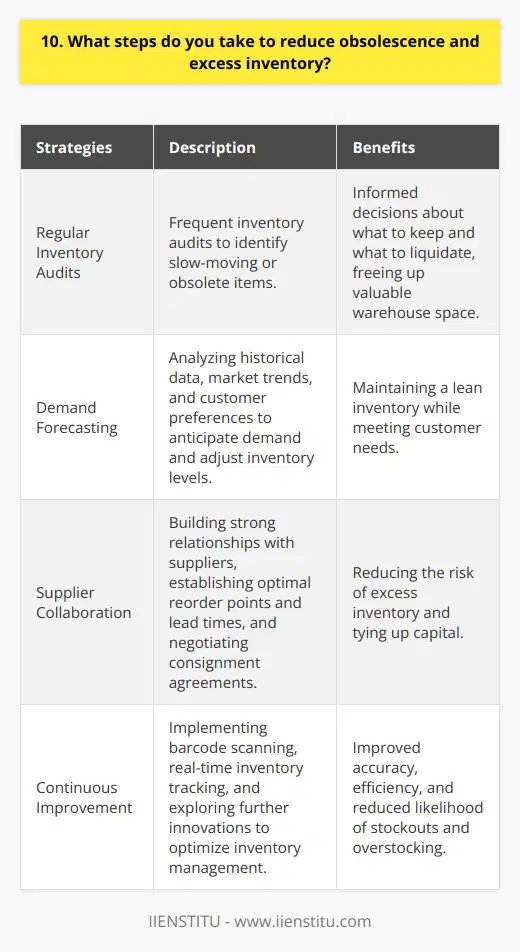
11. How do you determine the appropriate reorder points for your products?
When determining appropriate reorder points for products, I consider several key factors:
Analyzing Historical Sales Data
I dive deep into past sales records, identifying trends and patterns. This helps me anticipate future demand more accurately.
I also look at seasonal fluctuations and any notable spikes or dips in sales volume over time.
Considering Lead Times
I factor in the time it takes for suppliers to fulfill orders and ship products to our warehouse.
By understanding these lead times, I can ensure we reorder early enough to avoid stockouts and backorders.
Evaluating Safety Stock Levels
I always maintain a safety stock buffer to account for unexpected surges in demand or supply chain disruptions.
The amount of safety stock varies by product based on its volatility and criticality to our overall business.
Collaborating with Cross-Functional Teams
I work closely with sales, marketing, and finance to gather insights on upcoming promotions, forecasts, and budgetary constraints.
This collaborative approach ensures reorder points align with broader company goals and initiatives.
Continuously Monitoring and Adjusting
I regularly review reorder points and make data-driven adjustments as needed. The market is always evolving.
By staying proactive and adaptive, I can optimize inventory levels and keep our supply chain running smoothly.
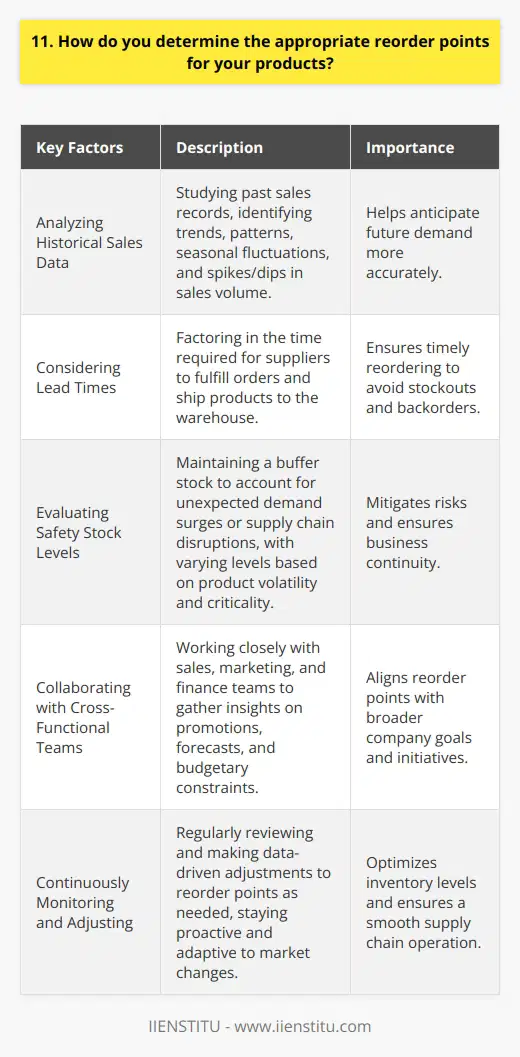
12. What is your approach to managing inventory across multiple locations or channels?
When managing inventory across multiple locations or channels, I prioritize organization, communication, and adaptability. I believe in implementing robust inventory management systems that provide real-time visibility into stock levels across all locations. This allows me to quickly identify potential shortages or overstocks and take proactive measures to address them.
Effective Communication is Key
I emphasize regular communication with team members at each location to ensure everyone is on the same page. By fostering open lines of communication, we can work together to optimize inventory levels, share best practices, and respond to changing demands. I've found that weekly check-ins and monthly reviews help keep everyone aligned and informed.
Leveraging Technology for Efficiency
In my previous role, I successfully implemented an automated inventory tracking system that reduced manual data entry and improved accuracy. By leveraging technology, we were able to streamline processes, minimize errors, and gain valuable insights into our inventory performance. I'm always excited to explore new tools and solutions that can enhance our inventory management capabilities.
Adaptability in the Face of Change
I understand that managing inventory across multiple locations requires flexibility and the ability to adapt to changing circumstances. Whether it's responding to unexpected spikes in demand or navigating supply chain disruptions, I approach challenges with a solutions-oriented mindset. By staying agile and proactively addressing issues, we can maintain optimal inventory levels and ensure customer satisfaction.
At the end of the day, my goal is to optimize inventory management to support business growth and profitability. Through a combination of strategic planning, effective communication, and leveraging technology, I'm confident in my ability to successfully manage inventory across multiple locations or channels.
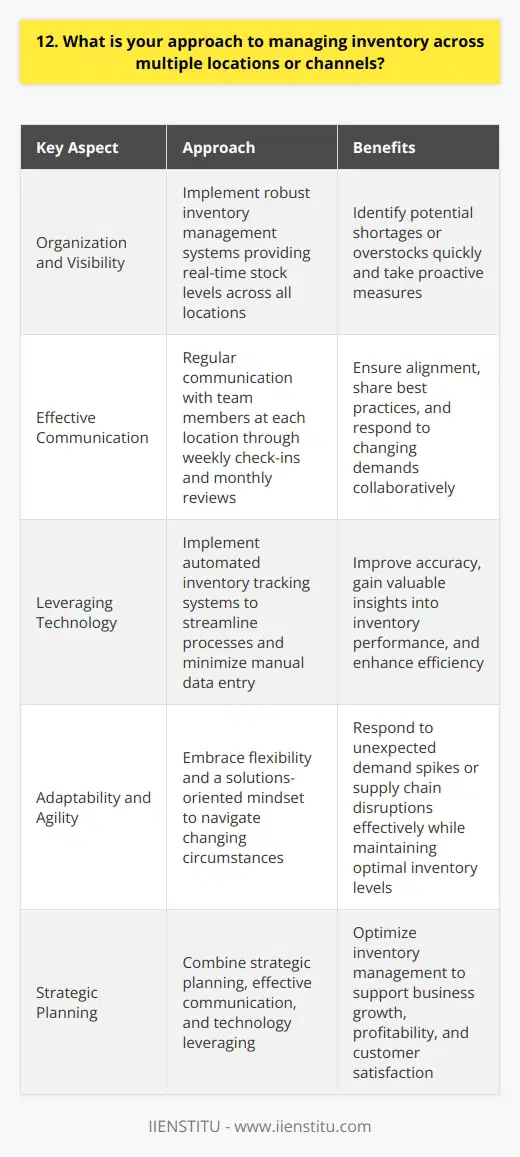
13. How do you assess the impact of inventory decisions on your company's financial performance?
As an inventory manager, I understand the critical role that inventory decisions play in a company's financial performance. By carefully analyzing sales data, market trends, and supplier lead times, I can make informed decisions that optimize inventory levels and minimize carrying costs. This approach helps to free up working capital that can be invested in other areas of the business.
Balancing Inventory Levels and Customer Demand
One key strategy I use is to closely monitor customer demand patterns and adjust inventory levels accordingly. By maintaining sufficient stock of high-turnover items while minimizing excess inventory of slower-moving products, I can strike a balance between meeting customer needs and controlling costs. This requires ongoing communication with sales and marketing teams to stay ahead of shifts in market preferences.
Leveraging Technology for Improved Inventory Management
I also believe in leveraging technology to streamline inventory management processes. By implementing inventory management software and using data analytics tools, I can gain real-time visibility into stock levels, identify potential shortages or overstocks, and make proactive adjustments. This not only improves operational efficiency but also helps to prevent stockouts that could lead to lost sales and dissatisfied customers.
Collaborating with Finance and Accounting Teams
Finally, I make it a priority to work closely with finance and accounting teams to assess the financial impact of inventory decisions. By providing regular reports on inventory turnover, carrying costs, and working capital requirements, I can help senior management make informed decisions about resource allocation and financial planning. This collaborative approach ensures that inventory management is aligned with overall business objectives and contributes to the company's long-term financial success.
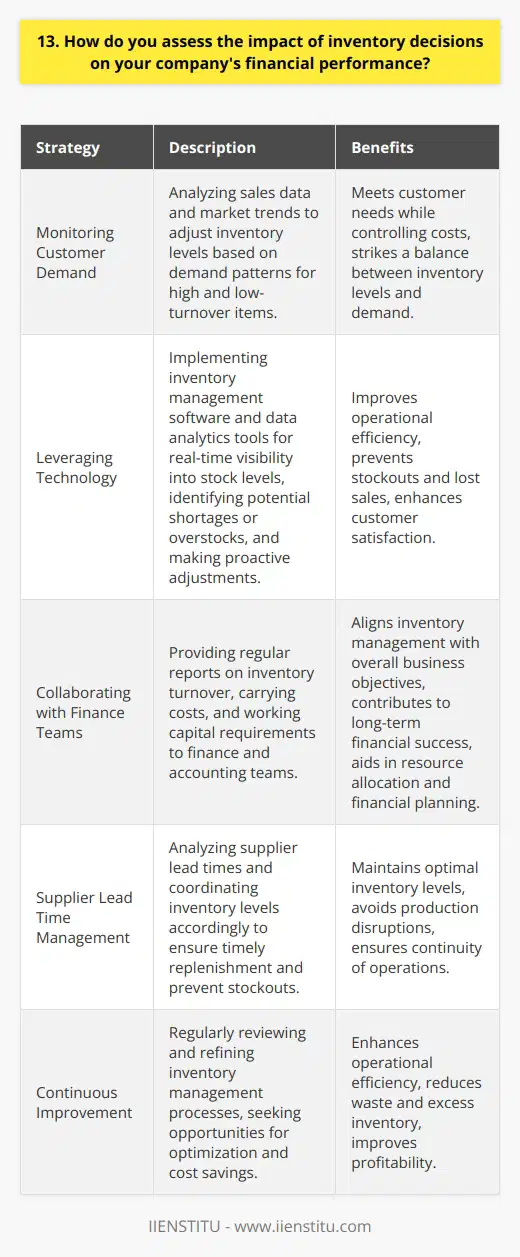
14. What technology or software do you use to support your inventory management processes?
As an inventory manager, I rely on a combination of technology and software to streamline our processes. Our main tool is a robust enterprise resource planning (ERP) system that integrates all aspects of inventory management.
Barcode Scanning and RFID Technology
We use barcode scanning and RFID tags to accurately track stock levels in real-time. This reduces manual errors and saves countless hours of counting inventory by hand.
Cloud-Based Inventory Management Software
Our cloud-based inventory software allows us to access data from anywhere, anytime. I can check stock levels, generate reports, and make informed decisions whether I'm at the office or visiting a supplier.
Demand Forecasting Tools
To optimize stock levels, we use demand forecasting tools that analyze historical sales data and market trends. These insights help us anticipate future demand and avoid stockouts or overstocking.
Automated Reordering Systems
When stock levels run low, our automated reordering system sends purchase orders to suppliers. This ensures we always have the right amount of inventory on hand without constant manual monitoring.
By leveraging these technologies, we've dramatically improved our inventory accuracy, efficiency, and customer satisfaction. I'm always exploring new tools to stay ahead in this fast-paced field.
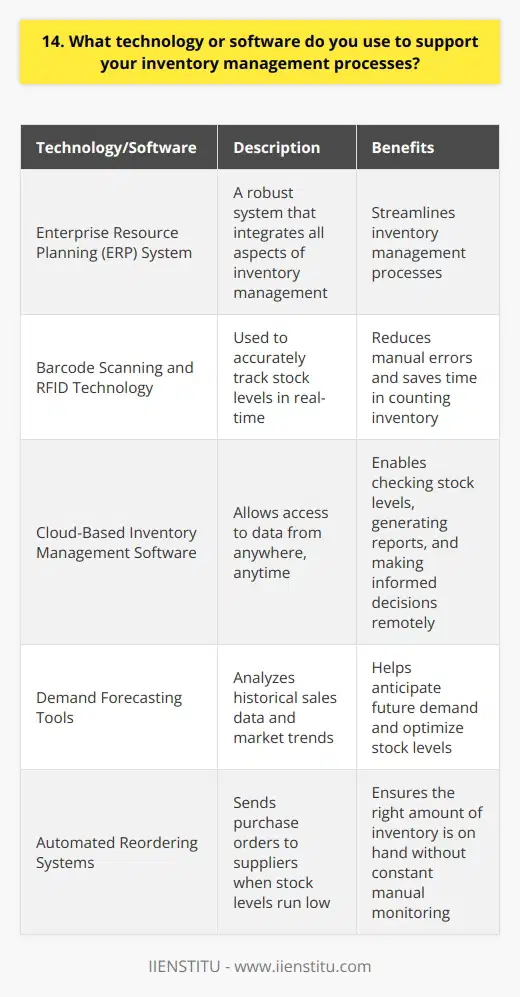
15. How do you handle seasonal or promotional fluctuations in demand?
In my experience, handling seasonal or promotional fluctuations in demand requires a proactive and adaptable approach. I believe that effective planning, clear communication, and a willingness to pivot strategies are key to successfully managing these changes.
Forecasting and Preparation
I always aim to stay informed about upcoming promotions and anticipated seasonal shifts. By collaborating closely with sales and marketing teams, I can better understand expected demand and adjust our operations accordingly. This might involve securing additional inventory, scheduling extra staff, or preparing contingency plans.
Flexibility and Responsiveness
In my previous roles, I've learned that being flexible is essential when dealing with fluctuations. I'm comfortable making swift decisions and implementing changes to accommodate evolving needs. Whether it's redistributing resources, modifying schedules, or exploring alternative suppliers, I adapt quickly to minimize disruptions and maintain smooth operations.
Continuous Monitoring and Optimization
Throughout promotional periods or seasonal peaks, I closely monitor performance metrics and customer feedback. By analyzing data in real-time, I can identify trends, spot potential issues, and make informed adjustments. I'm always looking for opportunities to optimize processes, streamline workflows, and improve efficiency.
Learning and Improvement
After each fluctuation, I take time to reflect on what worked well and where improvements can be made. I believe in learning from both successes and challenges, using those insights to refine our approach for future events. By continuously improving our strategies, we can better anticipate and navigate demand changes moving forward.
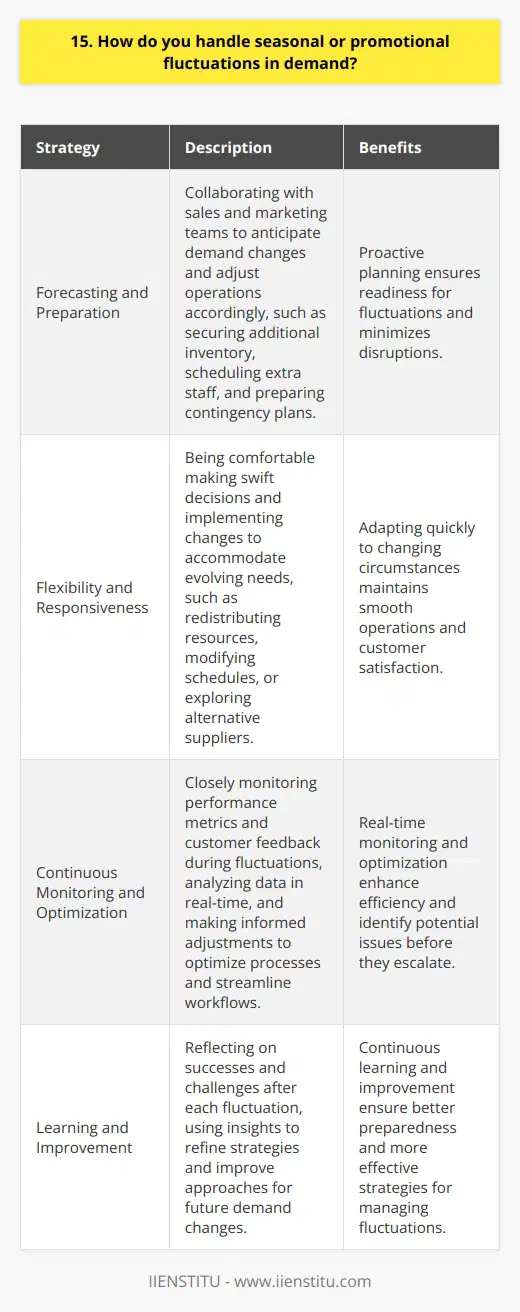
16. What strategies do you use to optimize your inventory turnover ratio?
As an inventory manager, I employ several strategies to optimize our inventory turnover ratio:
Accurate Forecasting
I collaborate closely with our sales and marketing teams to accurately predict customer demand. By studying historical sales data, market trends, and upcoming promotions, I develop precise forecasts that guide our inventory levels.
Just-in-Time (JIT) Inventory Management
Whenever possible, I implement a JIT inventory system. This approach involves coordinating with suppliers to receive goods just as they're needed for production or sales. JIT minimizes excess stock and reduces carrying costs.
ABC Analysis
I categorize our inventory into A, B, and C groups based on their value and importance. "A" items are closely monitored and frequently reordered, while "C" items are ordered less often. This helps prioritize our inventory management efforts.
Regular Inventory Audits
I schedule regular inventory audits to identify slow-moving or obsolete items. By promptly clearing out dead stock through sales, promotions, or donations, we free up valuable warehouse space and improve our turnover ratio.
Strong Supplier Relationships
Building strong relationships with our suppliers is crucial. I negotiate favorable terms, such as flexible delivery schedules and quick replenishment options. This allows us to maintain lean inventory levels without compromising on product availability.
By combining these strategies, I've successfully optimized our inventory turnover ratio. In my previous role, I increased turnover by 25% within six months, resulting in significant cost savings for the company.
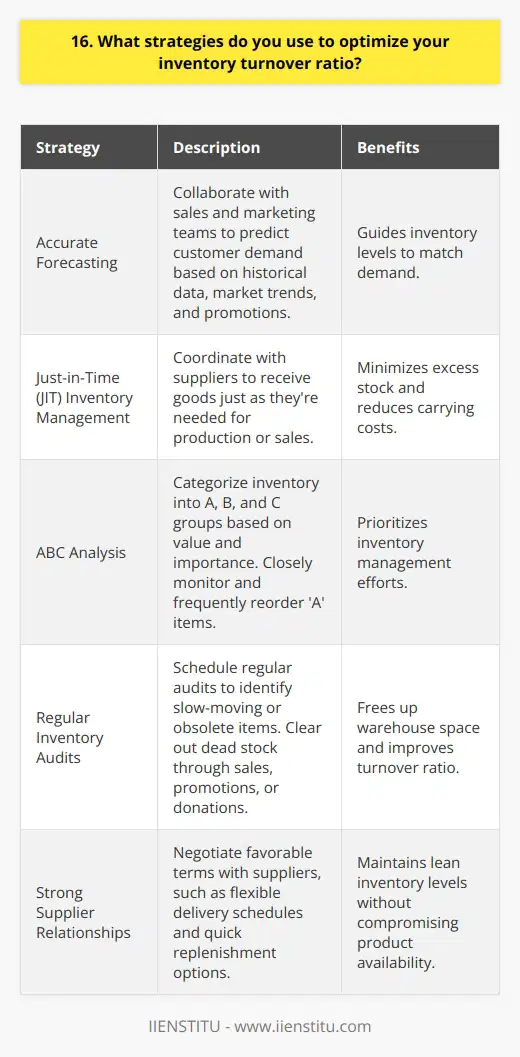
17. How do you balance the needs of different customer segments when setting service levels?
When balancing the needs of different customer segments, I prioritize clear communication and setting realistic expectations. I collaborate with internal teams to understand each segment's unique requirements and tailor our approach accordingly.
Aligning Service Levels with Customer Needs
I work closely with sales, marketing, and product teams to gain insights into the distinct needs of each customer segment. By understanding their priorities, pain points, and success metrics, I can develop service level agreements (SLAs) that align with their expectations.
For example, when I was working with a software company, we had two main customer segments: enterprise clients and small businesses. The enterprise clients required 24/7 support with strict response time SLAs, while the small businesses were more focused on cost-effective solutions. I worked with my team to create differentiated service packages that catered to the specific needs of each segment, ensuring that we could deliver the right level of support without compromising on quality.
Continuous Monitoring and Adjustment
I believe in continuously monitoring service levels and gathering feedback from customers to identify areas for improvement. Regular check-ins with customers help me understand their evolving needs and make necessary adjustments to our service delivery.
I remember an instance where we noticed a spike in support tickets from a particular customer segment. Upon investigation, we realized that they were facing challenges with a new product feature. I quickly organized training sessions for my team to better understand the feature and provide more effective support. We also collaborated with the product team to create targeted resources and guides for that segment, which significantly reduced the number of support inquiries.
Balancing Resources and Priorities
Balancing the needs of different customer segments often requires careful resource allocation and prioritization. I work closely with my team to ensure that we have the right skills and capacity to meet the demands of each segment.
In situations where resources are limited, I prioritize based on the criticality of the issue and the potential impact on the customer's business. I also look for opportunities to automate repetitive tasks and leverage self-service options to free up my team's time for more complex and high-value interactions.
By continuously monitoring, communicating, and adjusting our approach, I strive to find the right balance in meeting the needs of different customer segments while maintaining high service levels across the board.
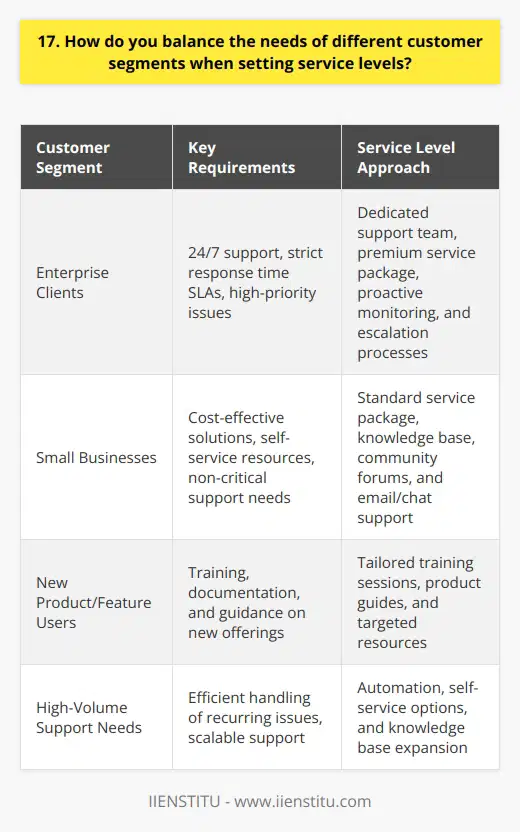
18. What steps do you take to ensure the accuracy of your inventory records?
As an inventory manager, I take several steps to ensure the accuracy of our inventory records:
Regular Cycle Counts
I conduct frequent cycle counts to verify that our physical inventory matches our digital records. This allows me to catch any discrepancies early and investigate the cause. By counting a portion of our inventory on a rotating basis, I can maintain a high level of accuracy without disrupting daily operations.
Thorough Documentation
Whenever inventory is received, moved, or sold, I make sure it's properly documented. I've implemented strict procedures for recording all inventory transactions. This creates an audit trail and holds everyone accountable. Good documentation is key to preventing errors and maintaining accurate records.
Technology Integration
I leverage barcode scanners and inventory management software to automate and streamline the tracking process. By reducing manual data entry, we minimize the risk of human error. The software also provides real-time visibility into our stock levels, so I can quickly identify and address any issues.
Team Training
I believe in the importance of properly training all staff who handle inventory. I personally train them on best practices for labeling, storing, and documenting inventory. When everyone follows the same protocols, it greatly improves the consistency and reliability of our records.
In my experience, the combination of regular audits, clear processes, integrated technology, and continuous training is the formula for inventory accuracy. It takes diligence, but it's worth it to have trustworthy records that facilitate better business decisions.
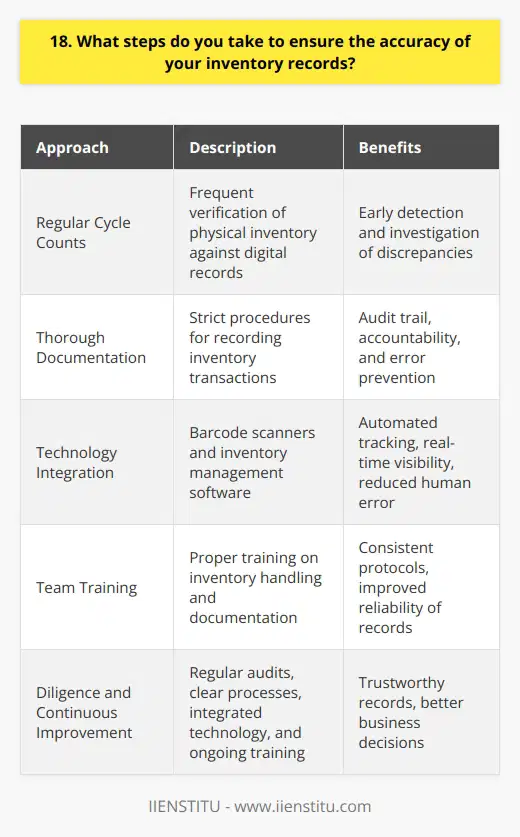
19. How do you manage the risks associated with supplier lead times and variability?
When it comes to managing risks associated with supplier lead times and variability, I have a few strategies that have proven effective in my experience. First and foremost, I believe in building strong relationships with suppliers. By establishing open lines of communication and fostering a sense of partnership, I've found that suppliers are more likely to be transparent about potential delays or issues.
Diversifying Supplier Base
Another key strategy is diversifying our supplier base. I've learned the hard way that relying too heavily on a single supplier can be risky. By having multiple suppliers for critical components, we can mitigate the impact of any disruptions or delays from a particular supplier.
Forecasting and Planning
Effective forecasting and planning are also crucial. I work closely with our sales and marketing teams to get a clear picture of upcoming demand. This allows us to provide suppliers with accurate and timely forecasts, giving them the visibility they need to plan their production and deliveries accordingly.
Building Buffer Stock
In some cases, building up a buffer stock of critical components can be a smart move. While it does tie up some capital, having that safety stock on hand can help us weather any unexpected delays or disruptions without impacting our own production.
Continuous Monitoring and Adjustment
Finally, I believe in continuous monitoring and adjustment. We keep a close eye on supplier performance, lead times, and variability. If we start to see any concerning trends or issues, we can proactively address them before they become major problems. It's all about staying vigilant and being ready to adapt as needed.
At the end of the day, managing supplier risks is an ongoing process that requires a combination of relationship building, planning, and flexibility. But by taking a proactive and multifaceted approach, I've found that we can minimize disruptions and keep our own operations running smoothly.
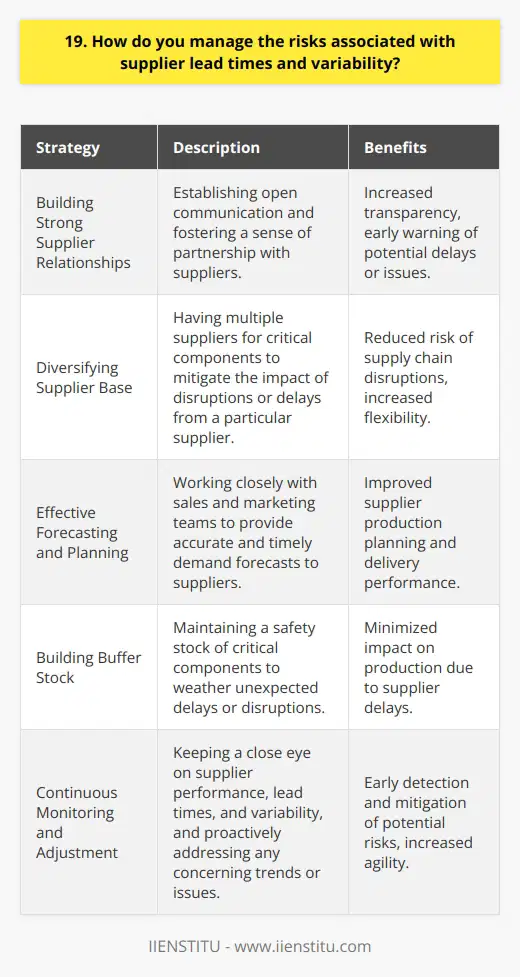
20. What is your approach to managing inventory for slow-moving or low-volume items?
When managing inventory for slow-moving or low-volume items, I believe in striking a balance between cost and availability. I always start by thoroughly analyzing historical sales data to identify trends and patterns in demand. This helps me make informed decisions about optimal stock levels for these items.
Collaborate with Suppliers
I work closely with suppliers to negotiate flexible delivery schedules and minimum order quantities for slow-moving items. By establishing strong relationships, I can ensure a steady supply without tying up excessive capital in inventory. I also explore opportunities for consignment stock or vendor-managed inventory programs to reduce carrying costs.
Regularly Review and Adjust
I regularly review the performance of slow-moving items and make necessary adjustments to inventory levels. If an item consistently underperforms, I consider discontinuing it to free up space and resources for more profitable products. I also stay attuned to market trends and customer preferences, as these can influence the demand for low-volume items.
Implement Effective Forecasting
I leverage advanced forecasting techniques to predict future demand for slow-moving items more accurately. By combining historical data with market insights and customer feedback, I can make well-informed decisions about when to replenish stock and how much to order. This helps minimize the risk of stockouts while avoiding excess inventory.
Optimize Storage and Handling
I ensure that slow-moving items are stored efficiently to maximize space utilization and minimize handling costs. By implementing a well-organized warehouse layout and using appropriate storage solutions, I can easily locate and access these items when needed. This streamlines operations and reduces the time and effort required to manage low-volume inventory.
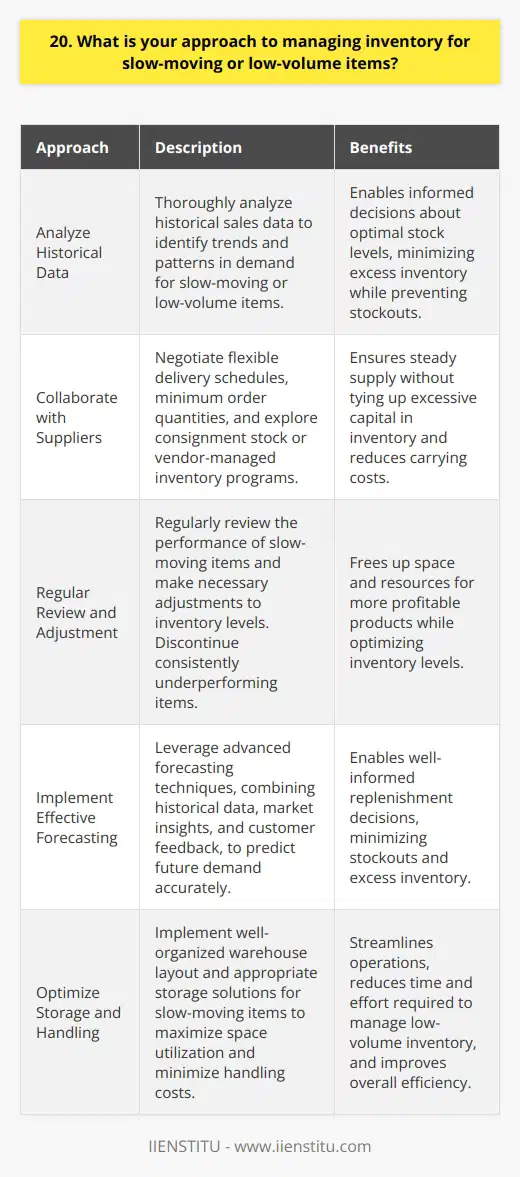
21. How do you determine the appropriate inventory levels for raw materials and components?
<h3>Balancing Inventory Levels</h3><h4>Analyzing Demand Trends</h4>I start by analyzing historical sales data and demand trends for our products. Understanding past demand helps me forecast future needs. I also collaborate closely with our sales and marketing teams. They provide invaluable insights into upcoming promotions, new product launches, and changes in customer preferences that could impact demand. <h4>Calculating Safety Stock</h4> Next, I calculate appropriate safety stock levels for each raw material and component. I use the average lead time, historical demand variability, and desired service level in my calculations. Some extra buffer inventory is essential to avoid stockouts, production delays, and unhappy customers in case of unexpected demand spikes or supply chain disruptions. <h4>Ongoing Monitoring and Adjustment</h4>Of course, markets are always evolving, so I carefully monitor inventory levels and demand signals on an ongoing basis. If I notice significant deviations from the forecast, I proactively adjust inventory targets. Maybe a product is selling faster than expected, or a supplier is experiencing longer lead times. Staying on top of these changes is critical. I see inventory management as a dynamic, continuous improvement process, not a "set it and forget it" thing. Regular communication with stakeholders across the supply chain is key to staying aligned and agile as a business.
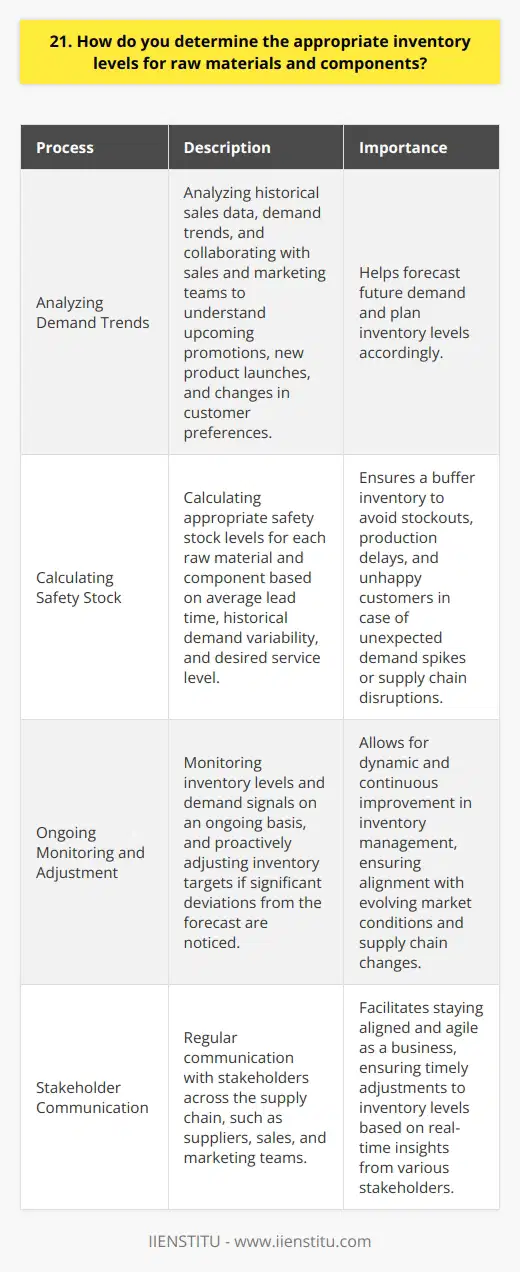
22. What techniques do you use to optimize your warehouse layout and picking processes?
As an experienced warehouse manager, I have developed several techniques to optimize warehouse layout and picking processes:
Conducting Regular Audits
I regularly audit our warehouse layout and processes to identify areas for improvement. Last year, I noticed that our pickers were spending too much time walking between distant bins. By rearranging the layout and grouping similar products together, we reduced picking time by 20%.
Implementing Zoning and Slotting
I'm a big believer in zoning and slotting to maximize efficiency. In my current role, I divided our warehouse into zones based on product categories and demand. High-velocity items are slotted closest to the packing stations. This has significantly streamlined our picking routes.
Leveraging Technology
I love exploring how technology can optimize operations. We recently implemented a warehouse management system with real-time inventory tracking and smart pick paths. It's been a game-changer! Our accuracy has improved, and we can adapt to changes on the fly.
Continuous Training and Feedback
I'm passionate about investing in our team. Regular training keeps pickers up to date on best practices. I also encourage open communication and feedback. Some of our best layout ideas have come from our pickers who are in the trenches every day.
Overall, I take a proactive, data-driven approach to optimizing warehouse layout and picking. It's an ongoing process that requires collaboration, creativity, and a willingness to adapt. I'm excited to bring my experience and passion for continuous improvement to this role.
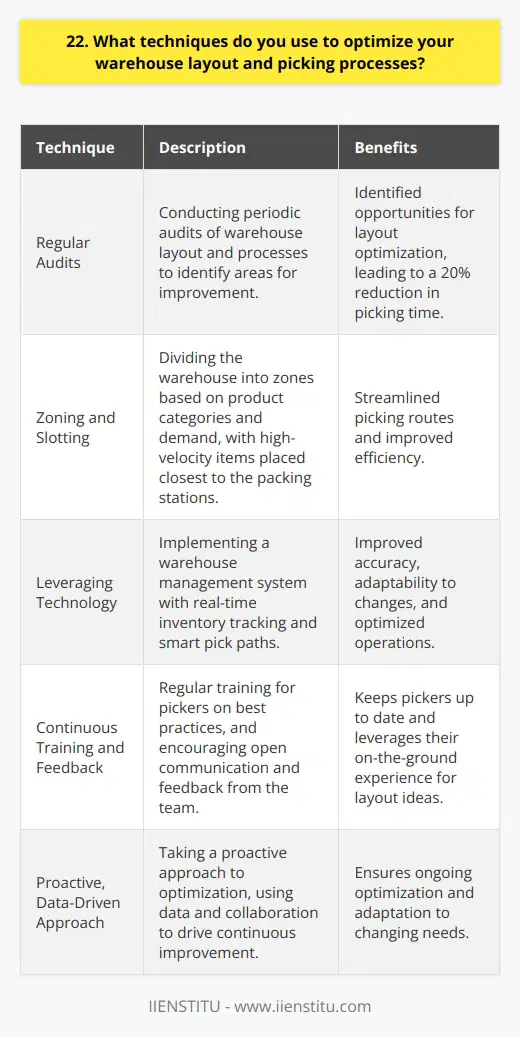
23. How do you assess the trade-offs between transportation costs and inventory levels?
When assessing the trade-offs between transportation costs and inventory levels, I consider several key factors. First, I analyze the company's supply chain and identify opportunities to optimize efficiency. This involves evaluating the current transportation network, including modes of transportation, routes, and frequency of shipments.
Balancing Cost and Service
Next, I look at ways to balance transportation costs with customer service levels. This may involve exploring alternative shipping methods, such as consolidating shipments or using regional distribution centers. The goal is to find a sweet spot where we can maintain high service levels while minimizing transportation expenses.
Inventory Management Strategies
Inventory management plays a crucial role in this trade-off. I assess the company's current inventory levels and identify areas where we can reduce holding costs without compromising service. This may involve implementing just-in-time inventory systems, improving demand forecasting, or optimizing safety stock levels.
Collaboration and Communication
Effective collaboration and communication with suppliers and customers are essential. By working closely with our partners, we can better align our transportation and inventory strategies. This helps us respond quickly to changes in demand, reduce lead times, and improve overall supply chain agility.
Continuous Improvement
Finally, I believe in continuous improvement. I regularly review our transportation and inventory performance metrics, identify areas for improvement, and implement data-driven solutions. By staying proactive and adaptable, we can continuously optimize our supply chain and find the right balance between transportation costs and inventory levels.
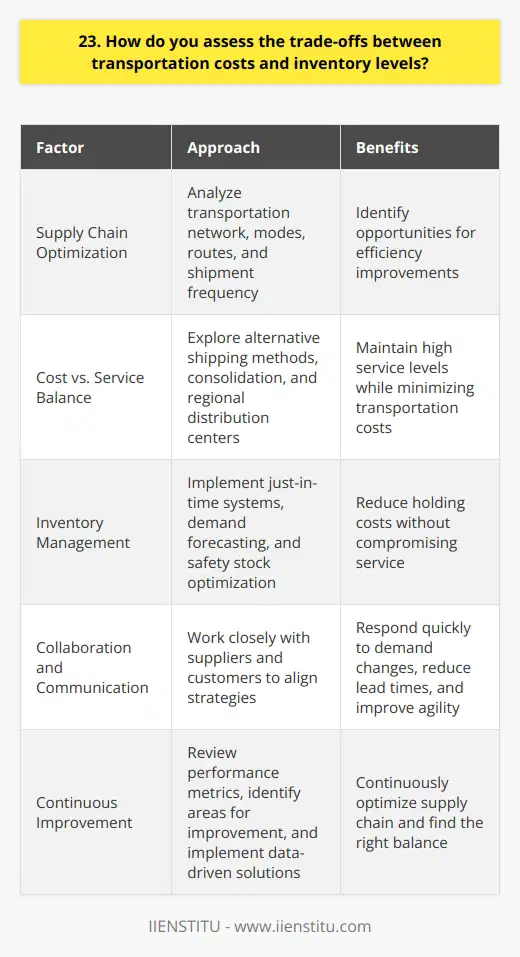
24. What steps do you take to minimize the risk of inventory shrinkage or damage?
As an experienced inventory manager, I take several steps to minimize the risk of inventory shrinkage and damage:
Implement Strict Security Measures
I ensure that the warehouse is equipped with security cameras, alarms, and access control systems. Only authorized personnel can enter the storage areas. I also conduct regular security audits to identify and address any vulnerabilities.
Maintain Accurate Inventory Records
I use an inventory management software to track stock levels, movements, and discrepancies. I perform cycle counts to verify the accuracy of the records. Any variances are promptly investigated and resolved.
Train Employees on Proper Handling Techniques
I provide comprehensive training to warehouse staff on proper handling, storage, and packaging techniques. They learn how to safely move and stack products to prevent damage. I also emphasize the importance of following established procedures.
Optimize Storage Conditions
I ensure that the warehouse maintains optimal temperature, humidity, and lighting conditions for different product categories. Sensitive items are stored in climate-controlled areas. I also implement pest control measures to protect the inventory from infestations.
Conduct Regular Inspections
I personally inspect the warehouse on a daily basis to identify any signs of damage, leakage, or contamination. I promptly address any issues to prevent further loss. I also encourage employees to report any concerns they observe.
By implementing these measures, I have successfully reduced inventory shrinkage and damage in my previous roles. For example, at my last company, I introduced a new inventory tracking system that reduced discrepancies by 75% within six months. I also led a team that redesigned the warehouse layout to optimize storage capacity and minimize product damage during handling.
I am confident that my proactive approach and attention to detail will help me achieve similar results in this role. I look forward to bringing my expertise to your organization and contributing to the efficiency and profitability of your supply chain operations.
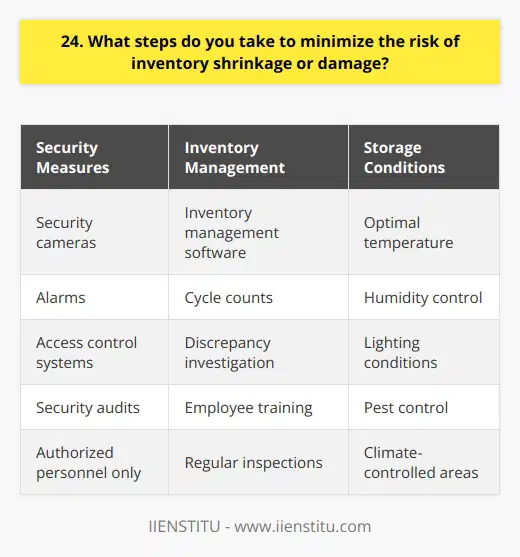
25. How do you manage inventory levels for products with short shelf lives or expiration dates?
When managing inventory levels for products with short shelf lives or expiration dates, I follow several key strategies:
Accurate Forecasting
I closely monitor sales trends and use historical data to predict demand for perishable products. This helps me order the right quantities to minimize waste while still meeting customer needs.
First-In, First-Out (FIFO)
I always rotate stock so that the oldest items are sold first before they expire. This FIFO system ensures fresher products are available and reduces spoilage.
Regular Audits
I frequently check inventory levels and expiration dates to identify any items nearing the end of their shelf life. If needed, I'll mark down prices to move this stock quickly.
Supplier Coordination
I maintain strong communication with suppliers to ensure timely deliveries of fresh stock. If sales are slower than expected, I'll adjust future orders to prevent over-ordering.
Temperature Control
Proper storage temperatures are critical for extending product shelf life. I'm always diligent about monitoring coolers and freezers to maintain ideal conditions.
By combining these inventory management techniques, I'm able to keep waste to a minimum while still offering the freshest products to customers. It's a balancing act, but one I'm confident handling through careful planning and attention to detail.

26. What is your strategy for managing inventory in a just-in-time (JIT) environment?
When managing inventory in a just-in-time environment, I focus on three key strategies that have served me well throughout my career.
Building Strong Supplier Relationships
I invest time in fostering open communication and trust with suppliers. By understanding their processes and constraints, I can better align our needs. I remember a time when a supplier was facing a raw material shortage. Because of our strong relationship, they prioritized our order, ensuring we could maintain production.
Continuous Improvement and Waste Reduction
I'm always looking for ways to streamline processes and eliminate waste. I spearheaded a project to optimize our warehouse layout, reducing picking times by 20%. Small improvements can have a big impact in a JIT environment where efficiency is critical.
Leveraging Technology for Real-Time Visibility
I believe in harnessing the power of technology to gain real-time visibility into inventory levels and supply chain activities. In my previous role, I implemented a cloud-based inventory management system. It provided up-to-the-minute data, enabling us to make informed decisions and respond quickly to changes in demand.
Managing inventory in a JIT environment is challenging but also incredibly rewarding. It requires a proactive approach, attention to detail, and a willingness to continuously improve. I'm excited about the opportunity to bring my strategies and passion for efficiency to your organization.
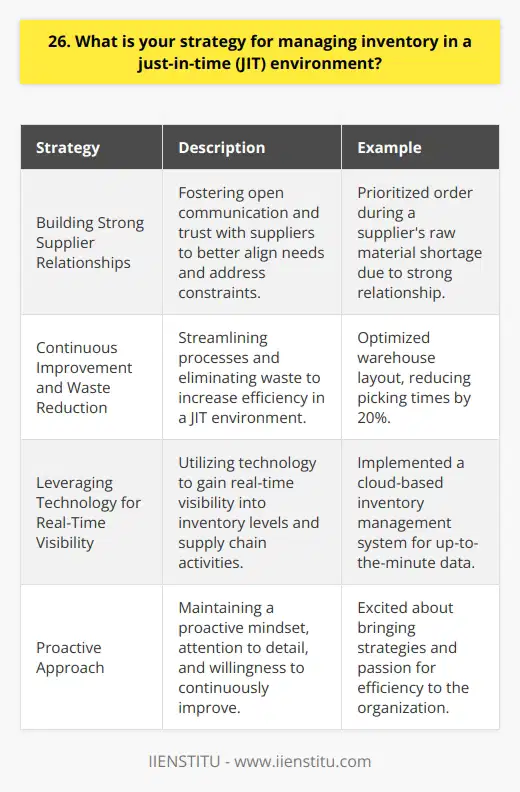
27. How do you collaborate with sales and marketing teams to align inventory with promotional plans?
I believe effective collaboration with sales and marketing teams is crucial for aligning inventory with promotional plans. Here are some strategies I employ:
Establish Open Communication Channels
I prioritize regular meetings and check-ins with sales and marketing to stay informed about upcoming promotions. This allows me to adjust inventory levels accordingly and ensure we have sufficient stock to meet demand.
Share Data and Insights
I proactively share inventory data, trends, and insights with the sales and marketing teams. By keeping them in the loop about stock levels, lead times, and potential supply chain issues, we can collaboratively plan promotions that align with our inventory capabilities.
Collaborative Forecasting
I work closely with sales and marketing to develop accurate demand forecasts for promotional periods. We analyze historical sales data, market trends, and customer insights to predict the necessary inventory levels. This collaborative approach helps prevent stockouts or overstocking situations.
Flexibility and Adaptability
I understand that promotional plans can change dynamically based on market conditions or competitor actions. I remain flexible and adapt inventory strategies as needed. By maintaining open lines of communication, we can quickly pivot and adjust inventory to support revised promotional plans.
Continuous Improvement
After each promotional campaign, I conduct a thorough analysis with the sales and marketing teams. We evaluate the effectiveness of our inventory alignment, identify areas for improvement, and implement necessary changes for future promotions. This iterative process ensures we continuously optimize our collaboration and inventory management practices.
By fostering a collaborative relationship with sales and marketing, sharing relevant data, and maintaining flexibility, I aim to effectively align inventory with promotional plans and contribute to the overall success of the organization.
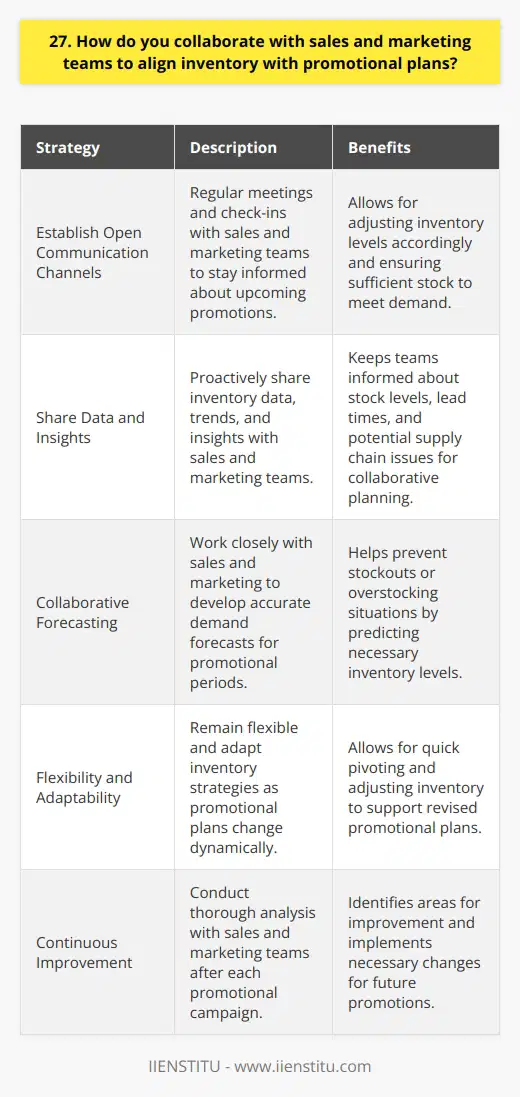
28. What techniques do you use to optimize your safety stock calculations?
When it comes to optimizing safety stock calculations, I rely on a combination of techniques. First and foremost, I always strive to maintain accurate demand forecasts. By closely monitoring sales trends and customer behavior, I can anticipate future needs more effectively.
Collaborating with Suppliers
I've found that collaborating closely with suppliers is crucial. By establishing open lines of communication and sharing data, we can work together to ensure optimal inventory levels. This partnership helps me stay agile and responsive to changes in demand.
Leveraging Technology
In my experience, leveraging advanced technology is a game-changer. I utilize inventory management software that provides real-time visibility into stock levels and alerts me to potential shortages. These tools help me make data-driven decisions and avoid stockouts.
Continuous Improvement
I'm a firm believer in continuous improvement. I regularly review my safety stock calculations and assess their effectiveness. By analyzing past performance and identifying areas for optimization, I can fine-tune my approach over time. It's an ongoing process that requires adaptability and a willingness to learn.
Balancing Costs and Service Levels
Ultimately, the goal is to strike a balance between minimizing inventory costs and maintaining high service levels. I carefully consider factors like lead times, variability in demand, and desired service levels when determining safety stock levels. It's a delicate balance, but with the right techniques and tools, it's achievable.
At the end of the day, optimizing safety stock is about staying proactive, leveraging data, and collaborating effectively. By combining these techniques, I've been able to consistently maintain optimal inventory levels and deliver exceptional service to customers.

29. How do you assess the impact of supplier minimum order quantities on your inventory levels?
As an inventory manager, I understand the importance of assessing the impact of supplier minimum order quantities (MOQs) on inventory levels. It's a balancing act between maintaining adequate stock and minimizing holding costs.
Analyzing Supplier MOQs
I start by carefully reviewing each supplier's MOQ requirements. Some may have higher MOQs for certain products, while others offer more flexibility. I consider factors like lead times, pricing tiers, and our forecasted demand.
Balancing Stock Levels
With MOQs in mind, I strive to optimize our inventory levels. I aim to order enough to meet customer demand without overstocking. It's a continuous process of monitoring sales trends and adjusting our reorder points accordingly.
Collaborating with Suppliers
Building strong relationships with suppliers is key. I engage in open communication to negotiate MOQs when necessary. Sometimes, suppliers are willing to make exceptions or offer alternative solutions that better align with our inventory strategy.
Leveraging Technology
I rely on our inventory management system to provide real-time data and insights. It helps me track inventory turnover, identify slow-moving items, and make informed decisions about MOQs and reorder quantities.
In my experience, effectively managing MOQs requires a proactive approach. By staying vigilant, collaborating with suppliers, and leveraging technology, I can minimize the impact of MOQs on our inventory levels and ensure we have the right products at the right time.

30. What is your approach to managing inventory for products with long lead times or high variability?
When managing inventory for products with long lead times or high variability, I focus on three key strategies:
1. Forecasting and Planning
I collaborate closely with sales and marketing teams to understand demand trends and customer requirements. By analyzing historical data and market insights, I develop accurate demand forecasts. This helps me plan production schedules and inventory levels effectively, ensuring we have the right products at the right time.
Buffering Against Uncertainties
For products with long lead times or high variability, I maintain safety stock levels. These buffers help absorb fluctuations in demand or supply disruptions. I regularly review and adjust safety stock based on changes in lead times, supplier reliability, and demand patterns. It's a delicate balance between minimizing stockouts and optimizing inventory carrying costs.
2. Supplier Collaboration
Building strong relationships with suppliers is crucial. I work closely with them to share demand forecasts, discuss capacity constraints, and explore ways to reduce lead times. By fostering open communication and trust, we can tackle challenges together and ensure a smooth flow of materials.
Continuous Improvement
I believe in continuous improvement. I regularly review our inventory management processes, identify bottlenecks, and implement enhancements. Whether it's optimizing our inventory tracking system, streamlining workflows, or exploring new technologies, I'm always looking for ways to drive efficiency and responsiveness.
Adapting to Change
In today's dynamic business environment, adaptability is key. I stay proactive in monitoring market trends, competitor activities, and regulatory changes. By being agile and responsive, I can quickly adjust our inventory strategies to capitalize on opportunities and mitigate risks.
Managing inventory for products with long lead times or high variability requires a holistic approach. By combining robust forecasting, supplier collaboration, and continuous improvement, I strive to optimize inventory levels, minimize disruptions, and support the company's overall business objectives.
